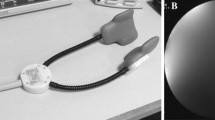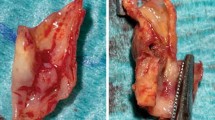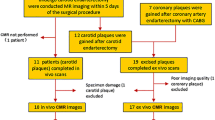Abstract
The American Heart Association modified classification for atherosclerotic plaque lesions has defined vulnerable plaques as those prone to rupture. The aim of our study was to assess the sensitivity and specificity of 1.5-T magnetic resonance imaging (MRI) in the evaluation of the characteristics of plaque components. Twelve carotid endarterectomy specimens were imaged by ex-vivo high-resolution 1.5-T MRI. Thirty-four cross-section axial images were selected for pixel-by-pixel basis analysis to demonstrate the most significant tissue features. Data were then submitted for histopathological examination and each specimen analysed in the light of the histological components (lipid core, fibrous tissue, fibrous/loose connective tissue, calcifications). The overall sensitivity and specificity rates for each tissue type were, respectively, 92% and 74% for the lipid core, 82% and 94% for the fibrous tissue, 72% and 87% for the fibrous/loose connective tissue, and 98% and 99% for calcification. The use of 1.5-T MRI appears to be a reliable tool to characterise plaque components and could help in the screening of patients with high risk of plaque rupture. The possibility of applying MRI in clinical daily practice may change the non-invasive approach to carotid artery diagnostic imaging, thus allowing an early identification of patients with vulnerable plaques.





Similar content being viewed by others
References
Spagnoli LG, Mauriello A, Sangiorgi G et al (2004) Extracranial thrombotically active carotid plaque as a risk factor for ischemic stroke. JAMA 292:1845–1852
Stary HC, Bleakley C, Dinsmore RE et al (1995) A definition of advanced types of atherosclerotic lesions and a histological classification of atherosclerosis. Arterioscler Thromb Vasc Biol 15:1512–1531
Redgrave JN, Lovett JK, Gallagher PJ, Rothwell PM (2006) Histological assessment of 526 symptomatic carotid plaques in relation to the nature and timing of ischemic symptoms: the Oxford plaque study. Circulation 113:2320–2328
Naghavi M, Libby P, Falk E et al (2003) From vulnerable plaque to vulnerable patient: a call for new definitions and risk assessment strategies: Part II. Circulation 108:1772–1778
Virmani R, Kolodgie FD, Burke AP, Farb A, Schwartz SM (2000) Lessons from sudden coronary death: a comprehensive morphological classification scheme for atherosclerotic lesions. Arterioscler Thromb Vasc Biol 20:1262–1275
Yuan C, Kerwin WS, Ferguson MS et al (2002) Contrast-enhanced high resolution MRI for atherosclerotic carotid artery tissue characterization. J Magn Reson Imaging 15:62–67
Ambrose JA, Tannenbaum MA, Alexopoulos D et al (1988) Angiographic progression of coronary artery disease and the development of myocardial infarction. J Am Coll Cardiol 2:56–62
Little WC, Constantinescu M, Applegate RJ et al (1988) Can coronary angiography predict the site of a subsequent myocardial infarction in patients with mild-to-moderate coronary artery disease? Circulation 78:1157–1166
Fuster V, Badimon J, Chesebro JH, Fallon JT (1996) Plaque rupture, thrombosis, and therapeutic implication. Haemostasis 26:269–284
Falk E (1992) Why do plaques rupture? Circulation 86:III30–III42
Narula J, Willerson JT (2006) Prologue: detection of vulnerable plaque. J Am Coll Cardiol 47:1
Fuster V, Stein B, Ambrose JA et al (1990) Atherosclerotic plaque rupture and thrombosis: evolving concepts. Circulation 82:II47–II59
Libby P (1998) The interface of atherosclerosis and thrombosis: basic mechanisms. Vasc Med 3:225–229
Coombs BD, Rapp JH, Ursell PC et al (2001) Structure of plaque at carotid bifurcation high-resolution MRI with histological correlation. Stroke 32:2516–2521
Rogers WJ, Prichard JW, Hu Y-L et al (2000) Characterization of signal properties in atherosclerotic plaque components by intravascular MRI. Arterioscler Thromb Vasc Biol 20:1824–1830
Hofman JM, Branderhorst WJ, ten Eikelder HM et al (2006) Quantification of atherosclerotic plaque components using in vivo MRI and supervised classifiers. Magn Reson Med 55:790–799
Hinton DP, Cury RC, Chan RC et al (2006) Bright and black blood imaging of the carotid bifurcation at 3.0T. Eur J Radiol 57:403–411
Hinton-Yates DP, Cury RC, Wald LL et al (2007) 3.0 T plaque imaging. Top Magn Reson Imaging 18:389–400
Clarke SE, Beletsky V, Hammond RR et al (2006) Validation of automatically classified magnetic resonance images for carotid plaque compositional analysis. Stroke 37:93–97
Virmani R, Burke AP, Kolodgie FD, Farb A (2003) Pathology of thin-cap fibroatheroma: a type of vulnerable plaque. J Interv Cardiol 16:267–272
Wolf RL, Wehrli SL, Popescu AP et al (2005) Mineral volume and morphology in carotid plaque specimens using high-resolution MRI and CT. Arterioscler Thromb Vasc Biol 25:1729–1735
Clarke SE, Hammond RR, Mitchell JR et al (2003) Quantitative assessment of carotid plaque composition using multicontrast MRI and registered histology. Magn Reson Med 50:1199–1208
Serfaty JM, Chaabane L, Tabib A et al (2001) Atherosclerotic plaques: classification and characterization with T2-weighted high-spatial-resolution MR imaging—an in vitro study. Radiology 219:403–410
Morrisett J, Vickc W, Sharmaa R et al (2003) Discrimination of components in atherosclerotic plaques from human carotid endarterectomy specimens by magnetic resonance imaging ex vivo. Magn Resonan Imaging 21:465–474
Dalager-Pedersen S, Falk E, Ringgaard S et al (1999) Effects of temperature and histopathologic preparation on the size and morphology of atherosclerotic carotid arteries as imaged by MRI. J Magn Resonan Imaging 10:876–885
Mauriello A, Sangiorgi G, Palmieri G et al (2000) Hyperfibrinogenemia is associated with specific histocytological composition and complications of atherosclerotic carotid plaques in patients affected by transient ischemic attacks. Circulation 101:744–750
Virmani R, Ladich ER, Burke AP et al (2006) Histopathology of carotid atherosclerotic disease. Neurosurgery 59:219–227
Stary HC, Chandler AB, Dinsmore RE et al (1995) A definition of advanced types of atherosclerotic lesions and a histological classification of atherosclerosis. A report from the Committee on Vascular Lesions of the Council on Arteriosclerosis, American Heart Association. Circulation 92:1355–1374
Toussaint J-F, LaMuraglia GM, Southern JF et al (1996) Magnetic resonance images lipid, fibrous, calcified, hemorrhagic, and thrombotic components of human atherosclerosis in vivo. Circulation 94:932–938
Shinnar M, Fallon JT, Wehrli S et al (1999) The diagnostic accuracy of ex vivo MRI for human atherosclerotic plaque characterization. Arterioscler Thromb Vasc Biol 19:2756–2761
Fayad ZA (2001) The assessment of the vulnerable atherosclerotic plaque using MR imaging: a brief review. Int J Cardiac Imaging 17:165–177
Yuan C, Mitsumori LM, Ferguson MS et al (2001) In vivo accuracy of multispectral magnetic resonance imaging for identifying lipid-rich necrotic cores and intraplaque hemorrhage in advanced human carotid plaques. Circulation 104:2051–2056
Toussaint J-F, Southern JF, Fuster V et al (1995) T2-weighted contrast for NMR characterization of human atherosclerosis. Arterioscler Thromb Vasc Biol 15:1533–1542
Takaya N, Yuan C, Chu B et al (2005) Presence of intraplaque hemorrhage stimulates progression of carotid atherosclerotic plaques: a high-resolution magnetic resonance imaging study. Circulation 111:2768–2775
Qiao Y, Ronen I, Viereck J et al (2007) Identification of atherosclerotic lipid deposits by diffusion-weighted imaging. Arterioscler Thromb Vasc Biol 27:1440–1446
Acknowledgements
The authors thank Dr Maurizio Ferretti and Dr Daniel Konda for their helpful support.
Author information
Authors and Affiliations
Corresponding author
Rights and permissions
About this article
Cite this article
Fabiano, S., Mancino, S., Stefanini, M. et al. High-resolution multicontrast-weighted MR imaging from human carotid endarterectomy specimens to assess carotid plaque components. Eur Radiol 18, 2912–2921 (2008). https://doi.org/10.1007/s00330-008-1091-x
Received:
Revised:
Accepted:
Published:
Issue Date:
DOI: https://doi.org/10.1007/s00330-008-1091-x




